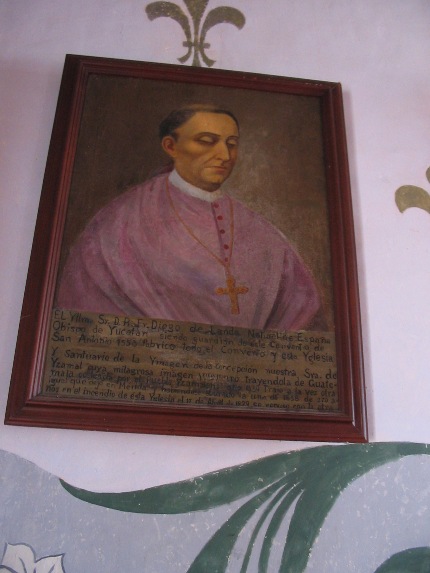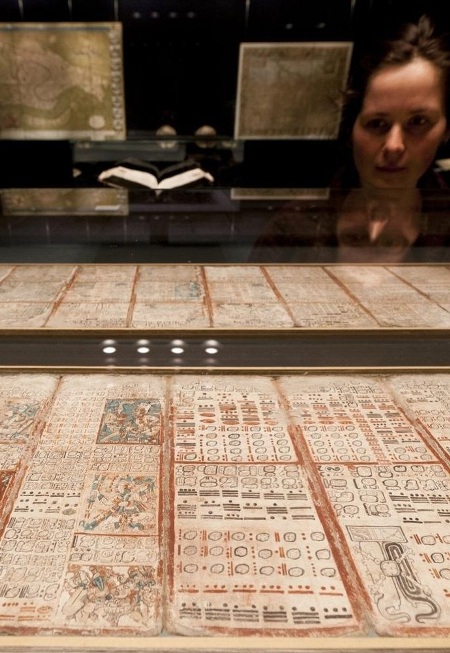Multiples adventures
Dominicans and Franciscans in Maya land - XVIth century
A trip by Las Casas to Tabasco and Chiapas
Pedro de Barrientos in Chiapa de Corzo
Las Casas against the conquistadores
Fuensalida and Orbita, explorers
Numerous studies
An ethnologist friar, Diego de Landa
Two teachers, Juan de Herrera and Juan de Coronel
Two historian friars, Cogolludo and Remesal
A multitude of buildings
A Franciscan turned architect: Friar Juan de Mérida
The Valladolid convent in the Yucatán
The Izamal convent and its miracles
In the Yucatán, a church in every village
A Dominican nurse, Matías de Paz
A difficult task: evangelization
The creation of the monastery of San Cristóbal
The Dominican province of Saint-Vincent
An authoritarian evangelization
Franciscans and the Maya religion
The failure of the Franciscans in Sacalum, the Yucatán
Domingo de Vico, Dominican martyr
The end of the adventure
Additional information
The Historia Eclesiástica Indiana of Mendieta
The road of Dominican evangelization in Guatemala
The convent of Ticul, as seen by John Lloyd Stephens
The Franciscans in the Colca valley in Peru
The convent route of the Yucatán in the XVIth century
The dominican mission of Copanaguastla, Chiapas
Available upon request: -
general information upon Maya countries, - numbered texts
on the conquest and colonization
of Maya countries
Address all correspondence to:
moines.mayas@free.fr
|
AN ETHNOLOGIST FRIAR:
DIEGO DE LANDA
|
Fray Diego de Landa
Diego de Landa Calderón was born in Cifuentes near Guadalajara on 12 November 1524. When he was 16 or 17, he entered the Franciscan convent of San Juan de los Reyes in Toledo. In 1549, he left for the Yucatan. He was appointed assistant to the guardian of Izamal and in 1552, became Guardian in charge of the construction of the permanent convent. In 1556, he became custodian of the Yucatan and head of the Franciscan Order of the Province. He was appointed as Provincial in 1561. He organized an important auto-da-fé in Mani on 12 July 1562 and punished pagan Indians and had many codexes and Mayan sculptures burned down. Following this event, he had to explain his actions before the Audience of Mexico, and then before the Consejo de Indias. He went back to Spain in 1563 to prepare for his lawsuit. Later, he lived in Guadalajara and Toledo as Master of the novices of San Juan de los Reyes. He probably wrote his “Relación de las cosas de Yucatán” there in 1566, to present his own version of the facts and defend himself. Once he was rehabilitated, he was appointed Bishop of Yucatan and returned there in 1572. He also wrote a christian doctrine in the Mayan language and had it published in Mexico in 1575. All copies have disappeared. He died in Merida in 1579.
Portrait of Diego de Landa formerly hanging in the Camarin of the Virgin in the convent of Izamal. This oil painting is part of a series of portraits of bishops of Yucatan. It is not known whether this portrait is a true reflection of Diego de Landa. On the foot appears a text that reads: "Illmo. Mr. D. Fray Diego de Landa del Orden Sepharico; native of the village of Cifuentes de la Alcarria; Guardian that was from the Convent of Itzmal, where he kept a large number of Indians in the hunger of 1553. The elected Bishop of Yucatan on April 30, 1572 took office the following year of 1573. He died on 29 April 1579, his death being very sensitive because of his exemplary life and opinion of holiness; he was buried in the Church of San Francisco, they moved his bones to the tomb of his fathers to the village of Cifuentes"
The historical traditions of the Yucatec Mayas
"The opinion of the Indians is that with the Itzás who settled Chichén Itzá there ruled a great lord named Cuculcán, as an evidence of which the principal building is called Cuculcán.
"They say that he came from the west, but are nor agreed as to whether he came before or after the Itzás, or with them. They say that he was well disposed, that he had no wife or children, and that after his return he was regarded in Mexico as one of their gods, and called Cezalcohuati. In Yucatan also he was reverenced as a god, because of his great services to the state, as appeared in the order which he established in Yucatan after the death of the chiefs, to settled the discord caused in the land by their deaths.
"This Cuculcán, having entered into an agreement with the native lords of the country, undertook the founding of another city wherein he and they might live, and to which all matters and business should be brought. To this end he chose a fine site eight leagues further inland from where Mérida now lies, and some fifteen or sixteen from the sea. They surrounded the place with a very broad wall of dry stone eighth of a league in extent, leaving only two narrow doorways; the wall itself was low. In the middle of the enclosure they built their temples, calling the largest Cuculcán, the same as at Chichén Itzá. They built another circular temple, different from all others in the country, and with four entrances; also many others about them, connected one with the other. Within the enclosure they built houses for the lords alone, among whom the country was divided, assigning villages to each according to the antiquity of their lineage and their personal qualifications. Cuculcán did not call the city after himself, as was done by the Ah-Itzaes at Chichén Itzá (which means the ‘Well of the Ah-Itzaes’), but called it Mayapán, meaning the ‘Standard of the Mayas’, the language of the country being known as Maya. The Indians of today call it Ich-pa, meaning ‘Within the Fortifications'"
(Chapter 6, Cuculkan. Foundation of Mayapan, translated by William Gates, Dover Publications, New York)
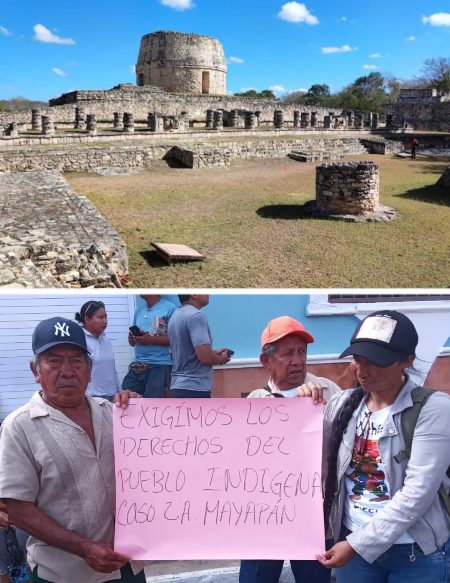
The Mayapán archaeological zone remain closed to the public since November 2023, the locals of Telchalquillo protesting unfair government pratice of no sharing admission profits with them
The Mayan calendars
Diego de Landa relates in his “Relación de las cosas de Yucatan” a great many facts about ancient history of the Mayas, their customs, their beliefs, their monuments, etc… He describes the calendar(s) of the Mayas, which enabled scientists to later put a date on them:
"They had their perfect year like ours, of 365 days and 6 hours, which they divided into months in two ways. In the first the months were of 30 days and were called U, which signifies the moon, and they counted from the rising of the new moon until it disappeared.
"In the other method the months had 20 days, and were called uinal hunekeh; of these it took eighteen to complete the year, plus five days and six hours. Out of these six hours they made a day every four years, so that they had a 366-day year every fourth time.
"For these 360 days they had 20 letters or characters by which to designate them, without assigning names to the five supplementary days, as being sinister and unlucky. The letters are as follows, each with its name above to understand their correlation with ours.
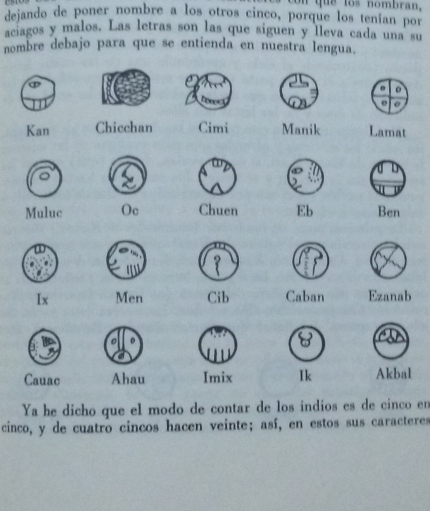
"I have already related that the Indian method of counting was from five to five, and four fives making 20; thus then from these 20 characters they take the first of each set of five, so that each of these serves for a year as do our Dominical letters, being the initials days of the various 20-day months (or uinals). Thus:
Kan
 Muluc
Muluc
 Ix
Ix
 Cauac
Cauac

"Among the multitude of gods worshipped by these people were four whom they called by the name Bacab. These were, they say, four brothers placed by God when he created the world, at its four corners to sustain the heavens lest they fall. They also say that these Bacabs escaped when the world was destroyed by the deluge. To each of these they give other names, and they mark the four points of the world where God placed them holding up the sky, and also assigned one of the four Dominical letters to each, and to the place he occupies; also they signalize the misfortunes or blessings which are to happen in the year belonging to each of these, and the accompanying letters."
(Diego de Landa, Relación de las cosas de Yucatán, Sec. 34. Count of the Yucatecan year. Characters of the days. The four Bacabs and their names. Gods of the “unlucky” days.).
"Not only did the Indians have a count for the year and months, as has been before set out, but they also had a certain method of counting time and their matters by ages, which they counted by 20-year periods, counting thirteen twenties, with one of the twenty signs in their months, which they call Ahau, not in order, but going backwards as appears in the following circular design.
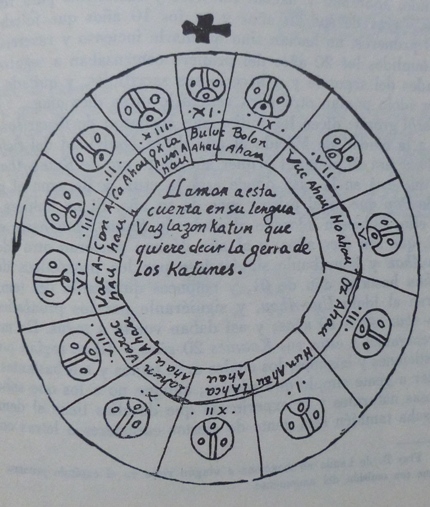
"In their language they call these periods Katuns, with these making a calculation of ages that is marvellous; thus it was easy for the old man of whom I spoke in the first chapter to recall events which he said had taken place 300 years before. Had I not known of this calculation I should not have believe it possible to recall after such a period. […]
"Verbi gratia. The Indians say that the Spaniards finally reached the city of Mérida in the year of Our Lord’s birth 1541, which was exactly at the first year of the era of Buluc (11) Ahau, which is in that block where the cross stands; also that they arrived in the month Pop’, which is the first month of their year."
(Diego de Landa, Relación de las cosas de Yucatán, Sec. 41. Cycle of the Mayas. Their writings).

Chichen Itza, 2023, April, archaelogist from INAH (Instituto Nacional de Antropología e Historia)
discovered a circular ballgame stone marker wich presents a low-relief band of glyphs surrounding two character dressed as ball players
The Mayan writings
Thanks to Diego de Landa, it was possible to decipher the Mayan writings, but only at the beginning of the 1950s. Before that date, Landa’s texts seemed unusable, as he had requested the Indians to write an alphabet primer for his own use. Since the Mayan writings are not based on the alphabet, the Indians drew signs that corresponded to the sounds A, B, or C, but which meant something entirely different. Research progressed only after this problem was solved and the ancient Maya language was deciphered.
"The sciences which they taught were the reckoning of the years, months and days, the festivals and ceremonies, the administration of their sacraments, the omens of the days, their methods of divination and prophecies, events, remedies for sicknesses, antiquities, and the art of reading and writing by their letters and the characters wherewith they wrote, and by pictures that illustrated the writings.
"They wrote their books on a long sheet doubled in folds, which was enclosed between two boards finely ornamented; the writing was on one side and the other, according to the folds. The paper they made from the roots of a tree, and gave it a white finish excellent for writing upon. Some of the principal lords were learned in these sciences, from interest, and for the greater esteem they enjoyed thereby; yet they did not make use of them in public."
(Diego de Landa, Relación de las cosas de Yucatán, Sec. 7. Government, priesthood, sciences, letters and books in Yucatan).
"They (the friars) learned to read and write in the Indian tongue, forming a grammatical system, so as to study it like the Latin. They found that six of our letters, D, F, G, Q, R, S, were not used or needed at all. Others however they had to double, and some to add, in order to understand the many meanings of some words. Thus pa means ‘to open’, and ppa, spoken by tightly compressing the lips, means ‘to break’; tan means ‘lime’, or ‘ashes’, and tan (t’an) uttered forcibly between the tongue and upper teeth means a ‘word’, or ‘to speak’. Apart from having different characters for these things, there was no need for inventing new forms of letters, but only to make use of the Latin ones, common to all."
(Diego de Landa, Relación de las cosas de Yucatán, Sec. 18. Vices of the Indians. Studies of the friars in the language of the country. Their teachings to the Indians. Conversions. Punishments of apostates).

A board of the Yucatan Regional Anthropological Museum in Merida
" Hieroglyphs
Maya writing was similar to Egyptian and Sumerian in that used symbols to represent complete words as well as phonetic signs to represent the syllabes of a word. Therefore words could be recorded in both different ways."
"These people also used certain characters or letters, with which they wrote in their books about the antiquities and their sciences; with these, and with figures, and certain signs in the figures, they understood their matters, made them known, and taught them. We found a great number of books in these letters, and since they contained nothing but superstitions and falsehoods of the devil we burned them all, which they took most grievously, and which gave them great pain."
"Of their letters we give here an a, b, c, their cumbersomeness not permitting more, because for all the aspirations of the letters they use one character, and then for uniting the parts another, going on in this way ad infinitum, as in the following example. Le means a lasso, and to hunt with one; to write it with their letters, they wrote them with three, at the aspiration of the l the vowel e, put before it; in this they are not at fault, although they use the e if they wish to do so for definiteness. Example: e l e l é; afterwards they put the syllable joined:
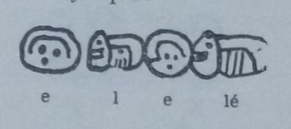
"Há means water; because the sound of the letter aitch is composed of a, h, before it, they put it at the beginning with a, and a ha at the end in this fashion:

"They also wrote in syllables, but in one and the other style; I only put it here in order to give a complete account of the matters of this people. Ma in kati means ‘I do not wish’, and they write it in syllables in this manner:
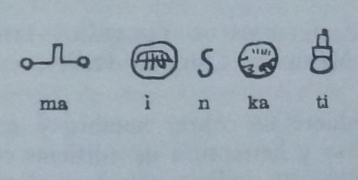
"Here begins their a, b, c:
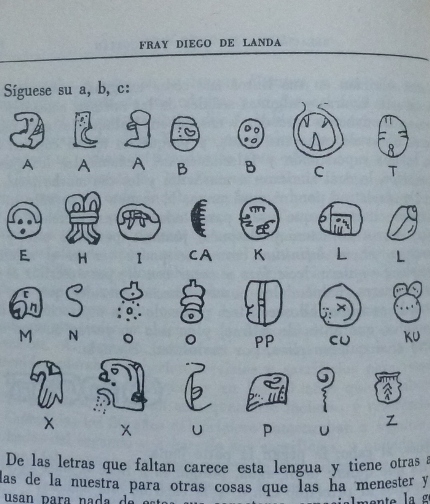
"The letters that do not appear are wanting in this language; and they have others in addition to ours, for other things where they are needed. But they no longer use any of the characters, especially the young people who have learned ours."
(Diego de Landa, Relación de las cosas de Yucatán, Sec. 41. Cycle of the Mayas. Their writings).
Fray Diego de Landa studying Mayan glyths with his indigenous informant (Drawing by Aaron Alfano in The Mayanist, Spring 2020)
José de Acosta (1589) :
"In the province of Yu-catan, where the Bishopricke is, which they call de Honduras, there were bookes of the leaves of trees, folded and squared after their manner, in the which the wise Indians contained the distribution of their times, the knowledge of the planets, of beasts and other naturall things, with their antiquities, a thing full of great curiositie and diligence. It seemed to some Pedant that all this was an inchantment & magicke arte, who did obstinately, maintaine that they ought to be burnt, so as they were committed to the fire. Which since, not onely the Indians found to be ill done, but also the curious Spaniards, who desired to know the secrets of the countrey.
"The like hath happened in other things, for our men thinking that all was but superstition have lost many memorialls of ancient and holy things, which might have profited much. This proceedeth of a foolish and ignorant zeale, who not knowing, nor seeking to knowo what concerned the Indians, say prejudicately, that they are all but witchcrafts, and that all the Indians are but drunkards, incapable to know or learne any thing. For such as would be curiously informed of them have found many things worthy of consideration."
(Joseph de Acosta, The Naturall and Morall Historie of the East and West Indies. Translated by E. G. London printed. 1604. lib. 5. chap. 7. Of the fashion of letters and writings which the Mexicaines used.)
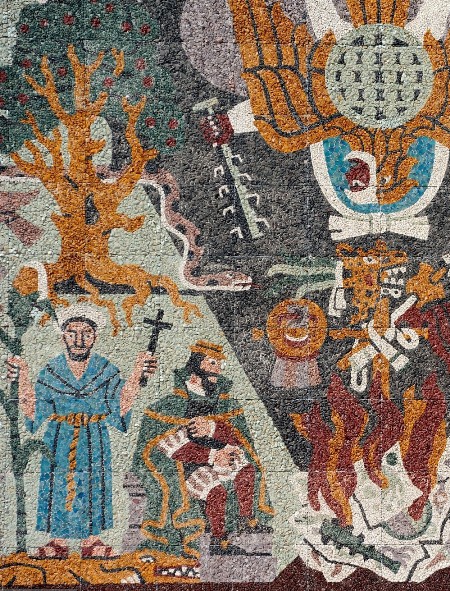
The burning of Maya codex, ordered by Fray Diego de Landa (Mural by Juan O’Gorman, Biblioteca Central de la UNAM -Universidad Nacional Autónoma de México-, Mexico city)
Diego López de Cogolludo:
"This Bishop [Fray Diego de Landa], who has passed for an illustrious saint among the priests of this province, was still an extravagant fanatic, and so hard hearted that he became cruel. One of the heaviest accusations against him, which his apologists could not deny or justify, was the famous auto-da-fe, in which he proceeded in a most arbitrary and despotic manner. Father Landa destroyed many precious memorials, which to-day might throw a brilliant light over our ancient history, still enveloped in an almost impenetrable chaos until the period of the conquest. Landa saw in books that he could not comprehend, cabalistic signs, and invocations to the devil."
"With the suspicion of this idolatry, they [the Franciscans] collected all the books and ancient writings which the Indians had and in order to erase all the danger and memory of their ancient rites, as many as they were able to find were burned publicly on the day of the "auto" and at the same time with this (were destroyed) the history of their antiquities."
(Diego López de Cogolludo, Historia de Yucatán, Libro IV, Capítulo VI. De la credencia de religión de estos indios, que parece haber tenido noticia de nuestra santa fe católica. 1688.)
The Dresden codex, one of the three Mayan Codex preserved, in the library of the town
Friar Bartolome de Las Casas:
“In all the republics of these great lands and kingdoms of New Spain and the others, among the other offices and officials that they had were those who served as chroniclers and historians. These [chroniclers] had notice of the origins of everything, equally that which touches on religion and gods and the worship of them as well as the foundations of their towns and cities, how the kings and lords and their territories began, and the modes of their election and succession, of how many and which lords have passed, of their works and exploits and memorable deeds, of how they governed well or badly, of the great men and vigorous, valiant captains, of the wars they had had and how they had distinguished themselves in them. Also, of the first customs of those who first populated and how these changed for better or worse, and all that which pertains to history so that there should be an account and record of past things.
"These chroniclers kept account of the days, months, and years, and although they did not have writing such as ours, they had nevertheless their figures and characters by which they could signify everything they desired; and their great books are of such astuteness and subtle technique that we could say our writing does not offer much of an advantage. Some of these books were seen by our clergy, and even I saw part of those which were burned by the monks, apparently because they thought [they] might harm the Indians in matters concerning religion, since at that time they were at the beginning of their conversion.
"There was never a dearth of these chroniclers, because the office passed from father to sons and it was a much esteemed office of the republic. He [the father] always instructed two or three brothers or relatives of that family as to what the histories discussed and made they practice with them while he still lived, and they came to him when they were in doubt about some articles or historical events.”
(Fray Bartolomé de Las Casas, Apologética Historia Sumaria, 1566, capítulo CCXXXV, Prosigue la materia del capítulo anterior. Tradiciones religiosas de los indios de Guatemala.)
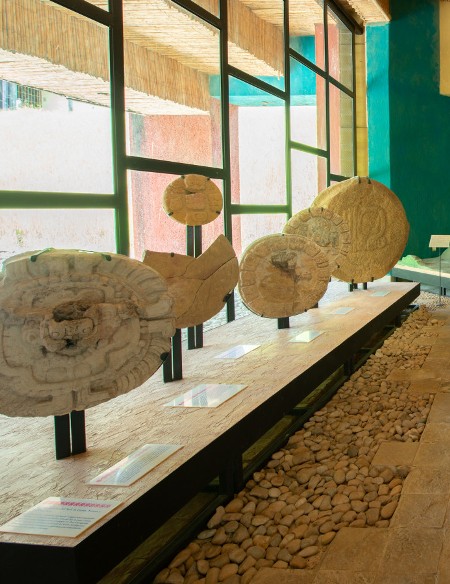
Site Museum of Toniná, Chiapas: the "coats of arms" described by the Dominican friar in his Isagoge
A Dominican friar who lived in Guatemala around the beginning of the eighteenth century wrote a chronicle of the Dominican province of San Vicente de Chiapa y Guatemala, "Isagoge Histórico Apologético general de todas las Indias ...". The Dominican’s methods of observation reveal an inquisitive intellect. The author of the Isagoge had to rely on his own insights for evaluating the pre-Conquest writing system.
« Among these buildings [in Toniná] there are also many coats of arms made of very hard stone, as hard as flint, having about five hand-spans [cuartas] in diameter, more or less. Their surface is all very uniform and terse, and all about their circumference there is a fringe close to a sesura [unit of measurement?] in width, and in this fringe many characters of various figures and ciphers, which Father Prebendary Friar Jacinto Garrido says are Chaldean letters.
Many of these statues and coats of arms have been taken to the town of Ocozingo, where I have seen them; and noticing the characters that the coats of arms bear as fringes, more than letters they seem to me like ciphers or hieroglyphs, meaning actions and events; because each of these figures is places in its little house, with its lines distinct from each to other, and each house has too much labor to be a single letter; and if that were so, a single word would be written in each of those coats of arms, at most. In one of these coats of arms a man of perfect stature can be seen sculpted in medium relief, feet and hands joined, and tied together with the same rope, so cleverly cramped into the circle of that coat of arms that within the diameter of a vara all the limbs of a man quite tall can be seen in natural size. In this coat of arms it seems they tried to indicate that they had subjected some great prince, or cacique, or some Indian nation, because the man shown tied, nude and with his hair in the manner of the Indians, seems to signify some cacique or Indian nation tied and violently subjected.”
(Isagoge Histórico Apologético general de todas las Indias y especial de la provincia de San Vicente Ferrer de Chiapa y Goathemala de el Orden de Predicadores, Chapter 10, 1711)

Yuri Knorozov, aged 75, at Tulum, in 1997, during a trip to Yucatan
Deciphering the Maya writing in 1970
"Before commenting on the writing and mathematical and astronomical advancement of the Maya, it must be confessed that we are far from deciphering the Maya writing in the way scholars have succeeded with the Egyptian and Sumerian. We have not really advanced very far at all in this study, and if not for the data left by Landa, we would probably be completely in the dark in this respect. Maya writing is hieroglyphic, that is, composed of ideographic elements and other phonetics. There was no true alphabet, what Landa presents to us as such is nothing more than the Maya graphic equivalent of the sounds of the Spanish alphabet. Various attemps have been made to decipher Maya writing, of which we know more or less one third of the ideographic signs and very few of the phonetic elements. The most recent attempt is that of the young Soviet ethnologist Knorozov; the little information that has reached us from this study does not permit a definitive judgement, but it seems to represent a serious effort to find the key to deciphering Maya hieroglyphs."
Alberto Ruz Lhuillier, The Civilization of the Ancient Maya, Instituto Nacional de Antropologia e Historia, México, 1970

Another board in the Anthropological Museum of Merida
" Reading the hieroglyphs
Friar Diego de Landa (16th century) was the first one who attempted to decipher the Mayan glyphs. In the 19th century, Ernest Forstemann deciphered the Mayan arithmetic system and calendars and Paul Schelhas identified the gods and the glyphs asssociated with them. In the 20th century, Yuri Knoroso discovered that the ancient Mayan signs could be read in a phonetic way, at the same time Heinrich Berlin and Tatiana Proskouriakoff verified that some inscriptions narrated historical facts."
The ethnologist friar of the Aztecs, Fray Bernardino de Sahagún, author of "Historia General de las Cosas de Nueva España":
"Fray Bernardino de Sahagún composed sermons in the Mexican language, covering the entire liturgical year, some long, some short, and also a gloss on the Sunday gospels and other tracts, all most polished. As a man who dug deep into the secrets and profundity of Náhuatl, he composed a Calepino [Historia General de las Cosas de Nueva España], consisting of twelve or thirteen volumes of high quality, which I am fortunate enough to have in my possession. Sahagún in this work describes the manner in which the Aztecs conversed on every imaginable subject, and enlarges on their morals, behavior, religion, education, etc. The work, being so massive, was too large for a single man to translate."
(Fray Jerónimo de Mendieta, Historia eclesiástica indiana, Libro IV, Capítulo XLIV, De lo mucho que escribieron los religiosos antiguos franciscanos en las lenguas de los indios)

Fray Bernardino de Sahagún, mural by Roberto Cuevas del Río, Escuela primaria Fray Bernardino de Sahagún, Ciudad Sahagún, Hidalgo, 1958
|
2025 "Friars and Mayas"
|
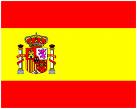

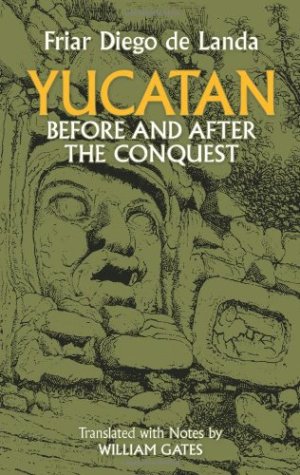
Friar Diego de Landa, Yucatan before and after the conquest (Landa's Relation), Dover Publications, Inc. New York, 1978
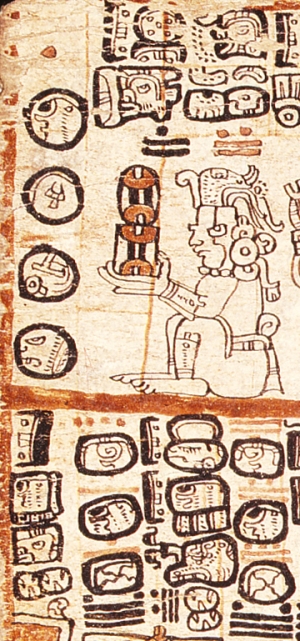
A page of the Codex Trocortesiano, or Codex of Madrid, astrological Mayan calendar dating to the XVIth century. It is one of the four codexes that remain.
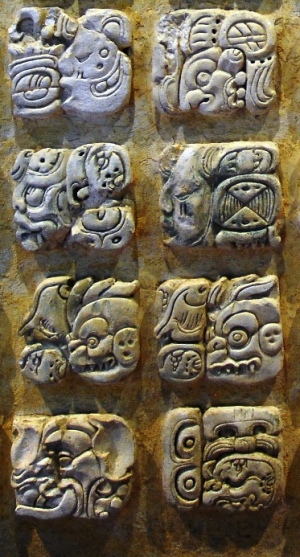
A sample of Mayan writings on a stele in the Museum of Palenque, Chiapas (VIIth century).
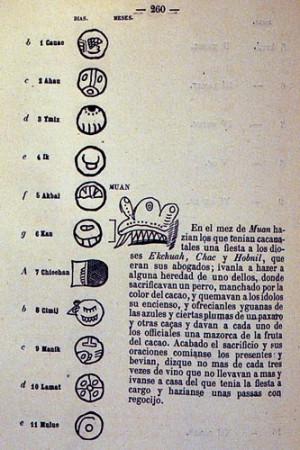
Diego de Landa, Relación de las cosas de Yucatán, edited and translated by abbot Brasseur de Bourbourg, Paris : Auguste Durand 1854.
The manuscript of Diego de Landa remained unknown up to the XIXth century. It was discovered in 1862 in the Royal Academy of History of Madrid by abbot Charles Etienne Brasseur de Bourbourg who translated it and published it in a bilingual French/Spanish version.
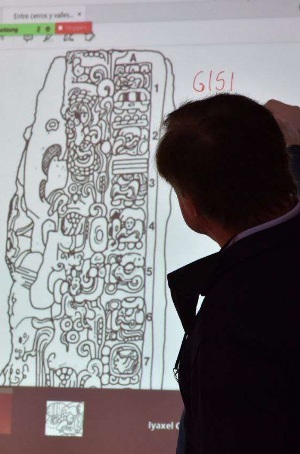
Huehuetenango, Guatemala, Augusr 2021, Maya epigraphic workshop
